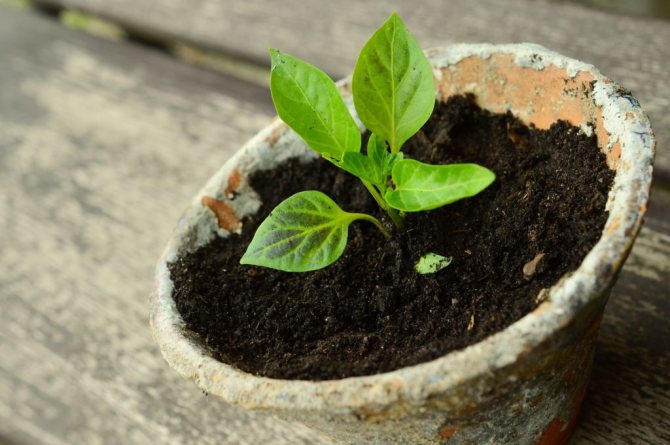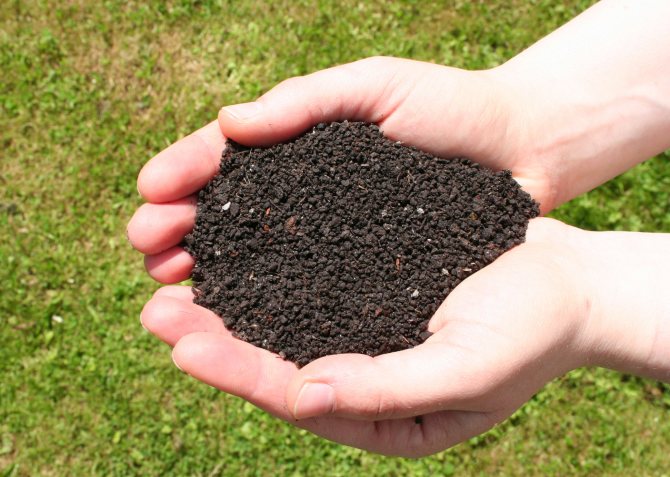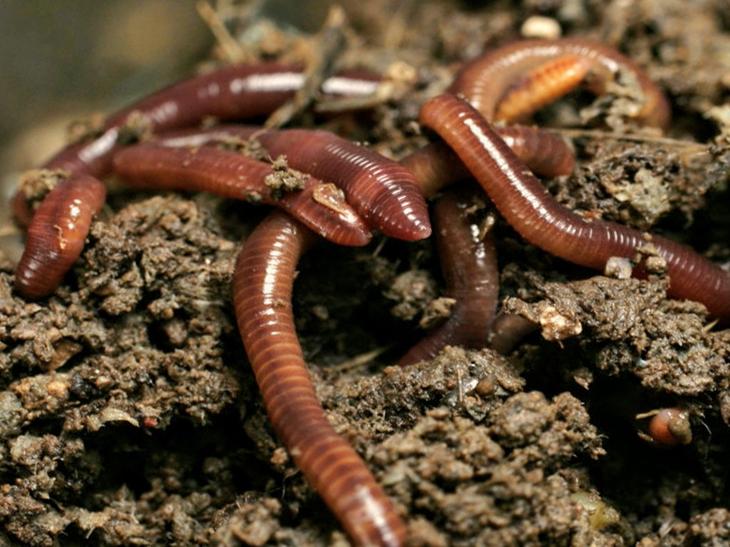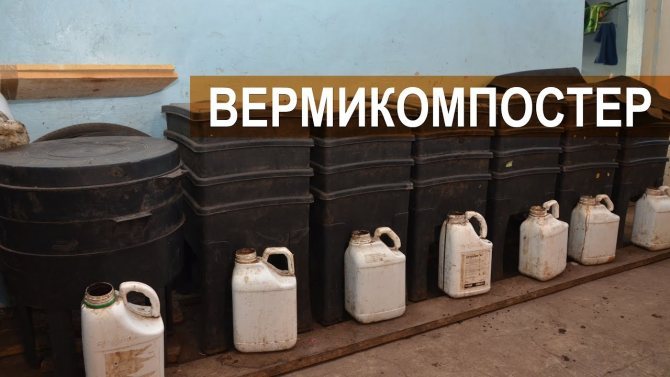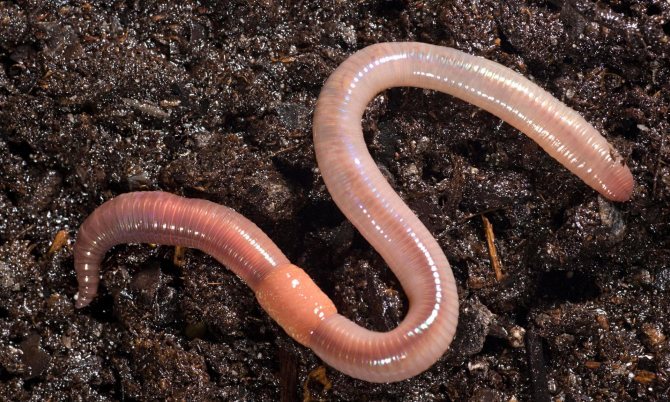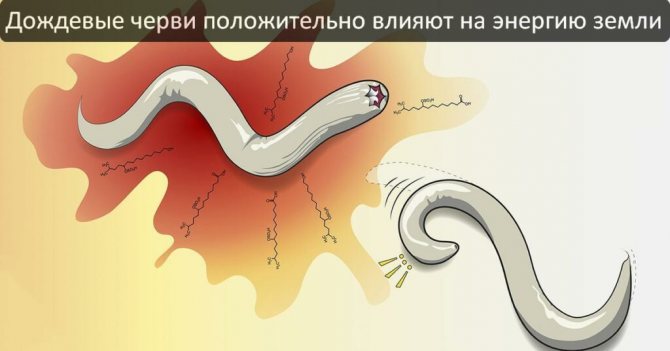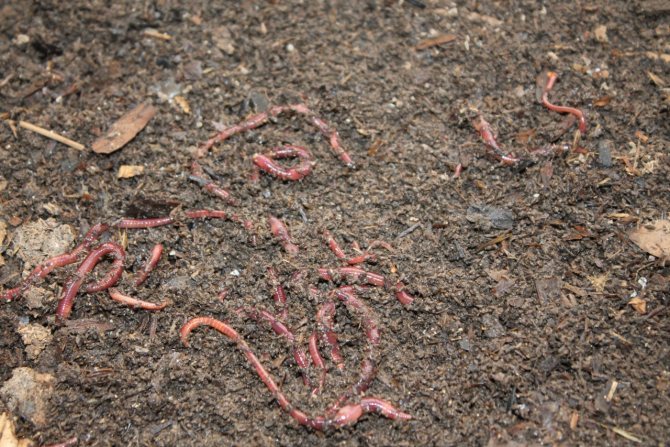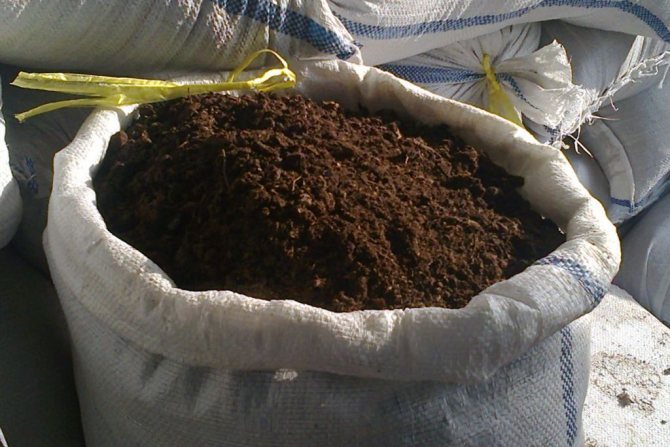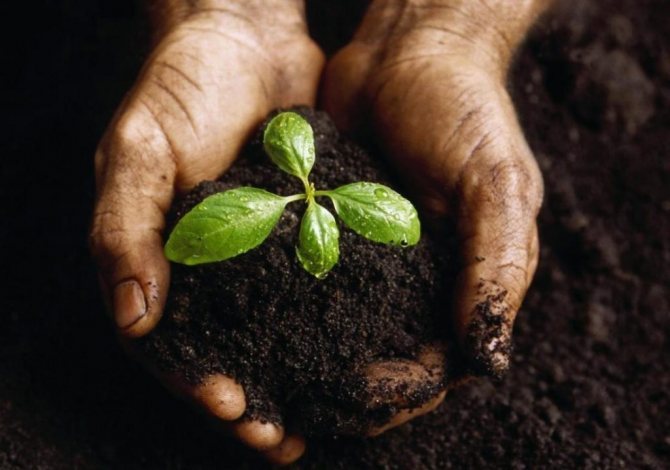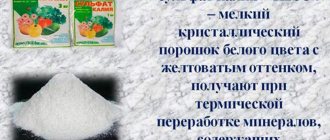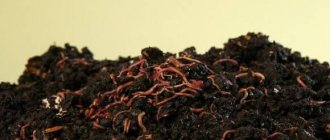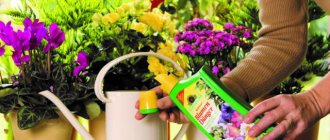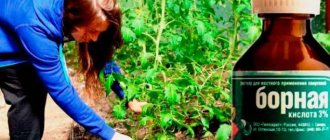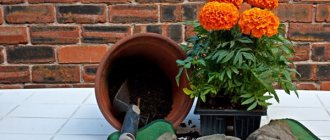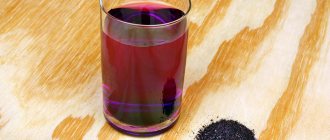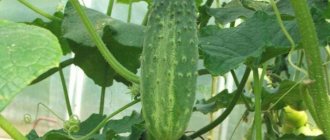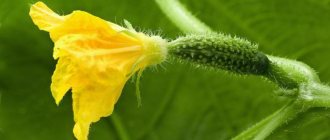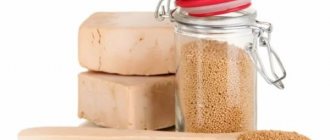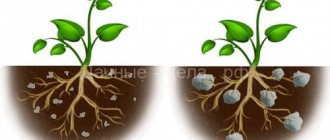Regular use of vermicompost for seedlings and field crops is an important condition for a good return of a high-quality crop. However, not everyone knows how to use it. It is widely used both in summer cottages and in huge agricultural areas.
Vermicompost is a product of processing plant residues by soil red Californian worms, which has excellent biologically active properties; it is an environmentally friendly, natural organic fertilizer (the so-called compost).
The technology of obtaining vermicompost was prompted by the processes that have been taking place in the soil for thousands of years. Perhaps the earthworm is one of the most ancient inhabitants of the planet. It is thanks to him and a number of soil microorganisms that there is a fertile soil layer on the earth. The worm, passing the soil lumps through its food tract, glues them together and transforms them into forms that are easily accessible to plants - caprolites.
In appearance, such soil has a well-aerated loose granular structure; it does not scatter in the form of dust over the surface. Dust is the first sign of disturbance in the structure and aeration of the soil horizon. Here one cannot do without additional input from outside vermicompost. Now it is received according to the same scheme that nature invented. A person only slightly makes his own adjustments in order to get a lot of vermicompost and in a short time, raising this process to an industrial scale. Nowadays, vermicompost for seedlings is simply necessary to quickly replenish and easily restore the lost fertility.
What are they used for?
Due to the regular and correct use of this type of organic fertilizers, many positive processes occur during the growing season of plants at any stage of its development:
- improving the agrotechnical properties of the soil, its structure, looseness, aeration;
- increases the ability to retain moisture in the soil, prevents the development of soil erosion and its destruction;
- the use of chemical fertilizers is reduced to naught;
- fertility, productivity, product quality is growing;
- increased resistance to diseases and pests;
- enhances immunity;
- acts as an obstacle to soil leaching and acidification;
- rapid growth and gain of biological mass of plants;
- enhances metabolism in cells and cellular respiration;
- causes an active growth of the increase in the biomass of fruits, accumulating in them more sugars, proteins, vitamins;
- reduces the harmful effects of nitrates;
- indoor and garden flowers bloom long and violently thanks to him.
Reviews of biohumus are only positive and for good reason. Easy to use, affordable, convenient to use, absolutely non-toxic to humans, animals or bees. After all, it is provided by nature and that says it all!
Rate the article:
Rating: 5/5 - 5 votes
Why use vermicompost?
Biohumus improves seed germination and stimulates root formation, germination, strengthening, as well as the development and flowering of small indoor plants. Reduces the amount of nitrates, heavy substances and various radionuclides in agricultural products, increases the level of sugars, vitamins and useful proteins in vegetables and fruits.
When liquid vermicompost is used for seedlings, it becomes possible to produce agricultural products of a sufficiently high quality and level of environmental friendliness, as well as significantly reduce the amount of losses during storage. Ordinary soil contains a huge amount of nutrients that cannot be normally assimilated by plants due to their insolubility. Liquid vermicompost for seedlings enters the plant through the root system, activates mechanisms that contribute to the normal splitting and assimilation of inaccessible nutrients.
The use of a humus solution for seedlings helps to protect the crops from all kinds of diseases. This substance is recommended for growing tomatoes and cucumbers in greenhouses. The level of infection of crops with root rot, powdery mildew and other diseases is significantly reduced. The substance has a beneficial effect on the quality of the grown products. In almost all types of plants, the amount of nitrates decreases, but the amount of proteins, sugars and other nutrients contained increases.
So, let's list the main properties of this substance.
- Stimulation of root formation.
- Stimulation of germination and good development of crops.
- Reducing the content of harmful nitrates.
- Increasing the content of useful vitamins in vegetables and fruits.
- Elimination of chlorosis, stimulation of the growth of indoor plants.
- Activation of root formation.
- Improving the immunity of horticultural crops.
- Accelerated rooting of small cuttings.
- Improving yields and accelerating ripening.
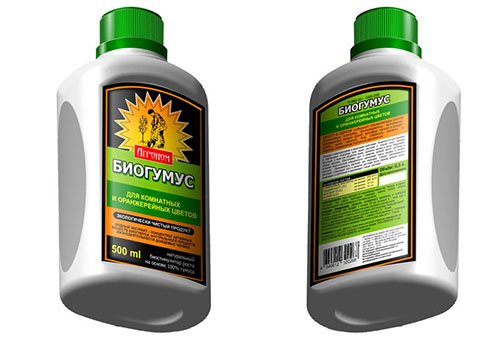
Fertilizer application instructions
Due to the versatility of vermicompost, it can be applied under any garden, horticultural, field and pot crops. It is used for pre-sowing seed treatment, increasing germination. To restore fertility, the waste product of the worms can be applied throughout the season. The product is presented for sale in two forms - dry granular vermicompost and liquid. Nutrient solutions are prepared from the latter. The powdery preparation is introduced under digging, laid in the trunk circles.
Liquid vermicompost
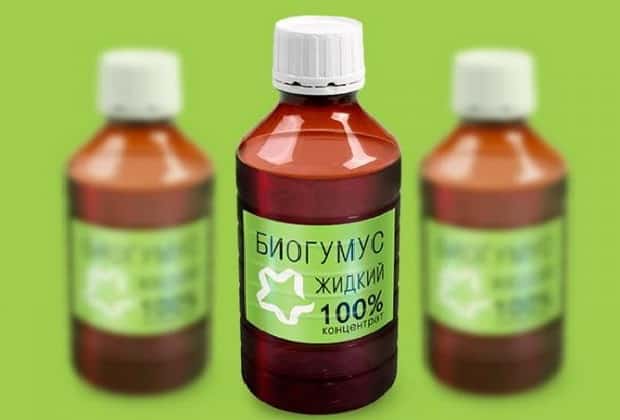

Due to its rapid absorption by the roots, this is the preferred form. Consumption is more economical, since the liquid vermicompost concentrate is diluted in water at the rate of 1:10 before use. The standard working mixture is additionally infused at room temperature for 24 hours. In some cases, it can be diluted with a smaller volume of water and made richer. It depends on the type of plant, vegetation phase, soil composition. All these nuances are provided in the instructions for the use of liquid vermicompost. Appointment of such a preparative form:
- feeding vegetative plants;
- seed treatment;
- spraying crops;
- pre-sowing soil preparation.
For your information!
Two problems that spraying with a nutrient solution solves, protecting crops from harmful organisms, improving the quality and quantity of fruits.
A working solution based on vermicompost is used during the planting of seedlings of fruit crops. Concentration is standard. A bucket of working solution is poured into each well. Root crops, cabbage, nightshade crops are very responsive to humus feeding. In order to avoid oversaturation with nutrients under garden flowers, the agent is applied twice a month in a ratio of 1: 1000.
Table 1. Instructions for the use of liquid vermicompost at different stages of culture development
| Processing period | Mode of application |
| Seed before sowing | Soak in a solution of 50 ml of concentrate and 1 liter of water. Consumption rate - ½ liter of working fluid per 1 kg of seeds. |
| Watering the soil with seedlings | The solution is prepared from 20 ml of the product per 1 liter of water. |
| Foliar and root feeding of vegetative plants | 5 ml of concentrated liquid is poured into a container with 1 liter of water. |
Sukhoi
Vermicompost is a healthy and safe top dressing. The frequency and volume of applications depend more on the physical and financial capabilities of the farmer. In the fall, during the preparation of the soil, 700 g of granules per 1 m2 are laid for digging. During the growing season, 500 g is used on the same planting area.
Table 2. Norms of vermicompost application during planting.
Composition of the substance - liquid and dry
The following substances were found in the composition of vermicompost:
- plant hormone-like chemical components that affect germination and growth rate;
- natural antibiotics that prevent the growth of pathogenic microflora;
- macronutrients - nitrogen, potassium, phosphorus;
- trace elements - sulfur, iron, copper, boron, zinc, manganese.
In a word - the entire set of essential nutrients for the production of amino acids and vitamins.


In addition to dry fertilizer, the industry produces a nutritious water concentrate - liquid vermicompost, the instructions for use say that 2 liters of solution replace half a centner of manure. Liter of concentrate need to be diluted in 10 liters of water, then water the beds. There are enough buckets 1 - 2 square meters.
Indoor Plants Application
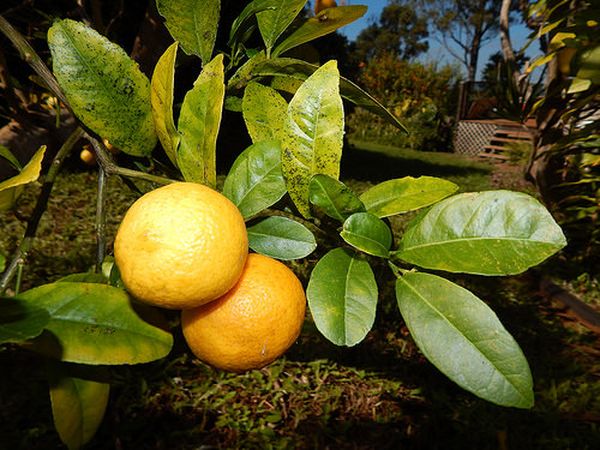

Domestic flowers really need timely fertilization, as they grow in greenhouses and they simply have nowhere to take food, except from the soil that is in the pot. For feeding houseplants, liquid soluble fertilizers are most often used, since this is a more convenient method. If plants organic fertilization is required, for example, vermicompost, then it is necessary to use only liquid fertilizing. The fact is that organic matter in its pure form, added to a pot with indoor plants, contributes to the appearance and reproduction of indoor midges, which will subsequently be very difficult to get rid of at home.
For feeding home flowers it is better to use an aqueous extract of vermicompost - the so-called vermicompost tea. You can prepare it in this way: add one glass of dry vermicompost to a container with 5 liters of cool water. Mix the resulting mixture well and let it brew for a day. The resulting tincture will contain all the useful substances of vermicompost necessary for the full development of indoor plants.
Vermicompost in liquid form for feeding houseplants is applied twice a month, by root or foliar treatments, depending on the state of the plant. Houseplants should be fed with vermicompost during the period from early spring to the end of June.
Work in the garden
Fertilizer is applied directly when digging the soil. You can also add dry or liquid vermicompost to the holes or between the rows.
Application of compost:
- for seedlings and seedlings in the greenhouse and open field;
- nutritious feeding of plants and seedlings;
- feeding indoor and ornamental garden plants;
- the use of vermicompost restrains the spread of weeds on the site.
When should vermicompost be applied to the soil? This organic fertilizer can be applied at any time when working on the site, except in winter. There is no specific measure for introducing vermicoppost - in any quantities. There are no recommendations for improving the soil either - this fertilizer is suitable for any soil.
Note! On average, about 0.5 kg of vermicompost can be added to 1 square meter of the plot.
Liquid vermicompost for watering seedlings is made very simply: you need to dilute a kilogram of fertilizer in a bucket of warm water. Seeds are also soaked in a liquid solution for friendly shoots. To do this, add 50 parts of warm water to a part of the vermicompost. The seeds are kept in solution for at least 10 hours. During this time, they will have time to absorb all the useful substances.
Further, the germinated seeds are sown in a container to which dry vermicompost is added in a ratio of 1: 3, that is, 3 parts of the earth are taken for a part of vermicompost. It is not recommended to plant sprouts in pure biohumus, otherwise they will react negatively to transplanting into ordinary soil.
When transplanting, a handful of vermicompost is poured into each hole on the site - this is quite enough to feed the seedlings. The fertilizer is mixed with the ground, then water is poured into the hole and the plant is planted.
In the future, the seedlings are watered with a nutrient solution (10 grams per liter) two to three times a month. Water the wells and spray the leaves. How much solution is used for one well? From half a liter to a liter.
When planting potatoes, the following guidelines must be followed. The tubers are pre-soaked in a solution of compost (3%) for 4 hours. Then add a handful of vermicompost to each well, or pour 1-2 liters of liquid fertilizer. When hilling bushes, they are sprayed with a 1% fertilizer solution.
To plant winter garlic, add 0.5 kg of dry or a liter of liquid fertilizer to each hole. For planting berry bushes, add 1.5 kg of compost to each hole. The hole is well watered, the earth around the bush is compacted.
How to cook vermicompost at home
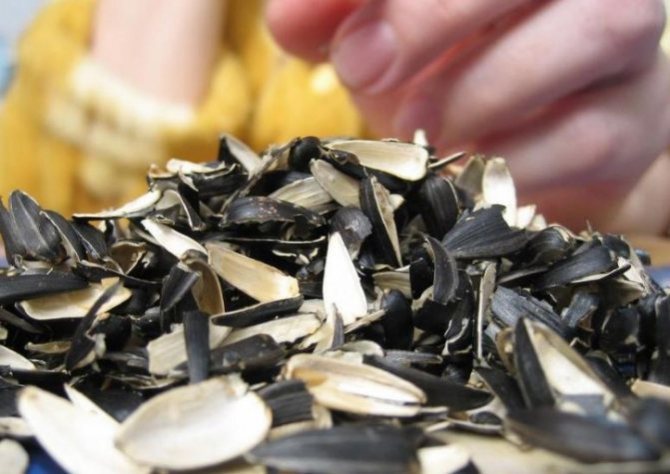

The tool can be prepared with your own hands. To do this, just follow the step-by-step instructions. Sequencing:
- Vegetable, fruit waste, seed husks, eggshells, bread leftovers are crushed using a blender or meat grinder.
- The ground mass is dried using sawdust or cardboard.
- A container is prepared, the bottom of which is covered with soil, 3 cm thick and worms are launched there;
- Holes are made at the bottom of the container for excess moisture to escape and in the lid to allow air to enter.
- Mix organic matter with soil.
- The mass obtained at the first stage is added as it is processed by invertebrates.
- Sometimes the contents of the container are moistened using heated water.
You can find worms yourself or buy them. In the latter case, before purchasing, pay attention to the mobility and color of invertebrates.. Californian red worms are more commonly used. They have a long life cycle, high efficiency, and they actively reproduce. Disadvantage - they do not tolerate low temperatures. There are other types of worms: prospector, earthworm and earthworm.
For your information!
Invertebrates are in the upper layer of the earth in a container, and the lower balls are vermicompost. Cooking time - 4-5 months, when the contents of the container must be removed.
How to cook with your own hands
If one of the farmers is interested in vermicomposting, then the next step is to figure out how to make vermicompost at home with your own hands. To do this, you need to choose the right type of worms that will process organic matter and create fertilizer.
There are a lot of varieties in nature. Some of them feed exclusively inside the soil, without going to the surface. Others collect leaf litter, such as the giant Altai allobophora. Red worms live in the topsoil, but feed on the surface.
Choosing the type of worms
It is best to give preference to those species that have already been tested by farmers and summer residents:
- Red Californian. It is considered a versatile species that lends itself to artificial breeding. Reproduces rapidly, and life expectancy 4 times more earthworm and is about 16 years old under favorable conditions. One ton of recycled organic matter mixed with soil gives about 600 kg of vermicompost, as well as an increase in individuals by 100 kg.
- Prospector - bred by Russian scientists and well adapted to domestic climatic conditions. The type of food does not matter - the worm easily switches to different sources of food.It hibernates in the soil at a depth, so excess livestock can be released into the wild. The species is not susceptible to disease. One worm per year creates 1 centner of vermicompost.
- Common, non-pedigree species also suitable for making humus at home with your own hands. Their activity is lower, but if you do not sell fertilizer, then it is quite enough for your plot.
You should take care of a worm house for wintering, especially if you plan to grow Californians. They will bunch up and freeze in the cold.
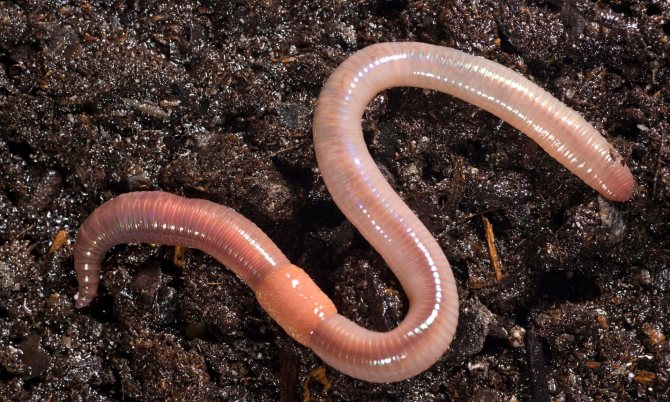

Necessary equipment and tools:
- containers with air holes;
- thermometer for maintaining air temperature;
- pH meter for soil acidity control;
- forks with blunt ends, a device for unloading the finished product, a bucket and a shovel.
First, you need to properly equip the wooden boxes for families. During the production of vermicompost, liquid will drain, therefore, a container is placed below to collect it. They also make boxes from an old refrigerator, cardboard or plastic - whoever has what. With a successful experience, you can buy a special vermicompost.
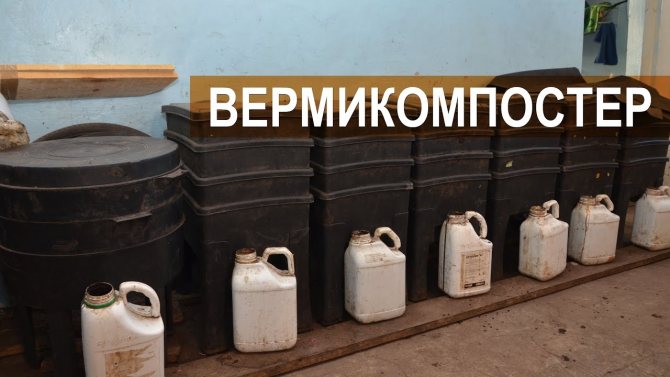

Family check-in:
- Pour humus into the box, add chopped cardboard, pour over with water and let stand 2 - 3 days.
- Make depressions and put the worms in there along with the soil in which they were previously. Sprinkle with soil on top and cover with cardboard.
- Wait 3 - 4 days, while individuals acclimatize.
- Add feed.
If it was found that several worms and all died at once, it is necessary to change the acidity of the soil. The optimal indicator is 6.5 - 7.5 units. You can increase the acidity with sawdust, and lower it with chalk.
Choice of feed
How to make humus at home and what to feed the worms:
- various plant residues - vegetables, fruits, leaves;
- tea or coffee brewing;
- egg peel;
- crackers without mold;
- whey or water from milk containers;
- straw, grass;
- fermented manure or droppings.
Do not add meat products, sour milk, fresh manure, the temperature of which will rise up to 70 degrees and the animals will die. It is recommended to pass the peel of vegetables and fruits through a meat grinder.
Video: How to use vermicompost in the garden
A new portion of food is bookmarked as it is processed. For this, feed is poured from above, the worms crawl in search of food, and the lower layer can be used to feed indoor or garden plants with vermicompost.
During active processing of food, it is necessary to maintain the moisture of the substrate, as well as periodically loosen the soil.
Cooking mistakes
You can lose some of the beneficial nutrients if you do not collect vermicelli - the flowing liquid. It can be obtained in large quantities and sold to neighbors in the country who are fond of indoor flowers.
Acidity is the main problem due to which the animal population is dying, therefore, before settling individuals, it is necessary to prepare the soil and measure the acidity level.
Depending on the type of worm, you need a warm or relatively warm worm for wintering. The lack of air in the room can also be the cause of the death of the population.
A constant change of food is undesirable, since young individuals prefer those products that they tried for the first time. It takes time for the family to get used to a different type of feeding.
A maximum of 50 thousand individuals can live on one square meter. Then they need to be resettled in other boxes or released into the wild.
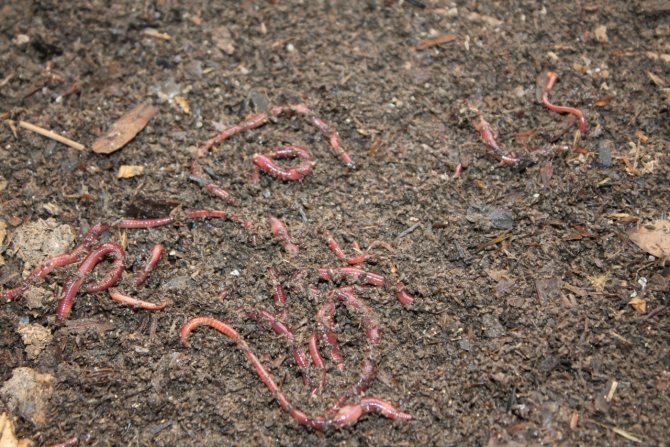

We make vermicompost on our own
The fertilizer is sold in dry and liquid form in horticultural stores, however, you can make your own compost. To do this, use wooden boxes or plastic containers with holes.Since the fertilizer is produced by worms of a certain breed (California), you need to buy a family of worms in a special store.
The composting process consists of five steps:
- buying worms;
- making a box;
- placing worms in compost;
- feeding the worms with a nutrient medium;
- fence of the finished compost.
Vermicompost is also produced by ordinary earthworms, which can be collected after rain. But you need red worms to create quality vermicompost. The most commonly used Californian breed.
Gardeners praise the Californian worms for their rapid reproduction and productive fertilizer production, however, they cannot withstand the Russian low temperatures. The worms work very productively: 50 individuals produce about 250 grams of the purest vermicompost per day.
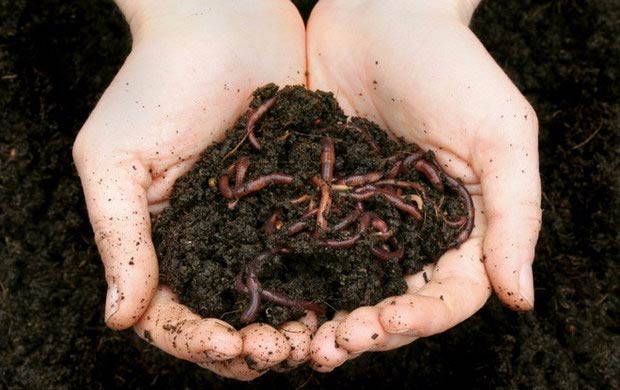

Important! When buying worms, pay attention to their color and mobility.
Unlike the California worm, the prospector breed (bred on the basis of dung worms) is distinguished by its adaptability to low temperatures. Under unfavorable conditions, the prospector worm knows how to hide in the depths of the soil so as not to die from the cold. The miner actively produces vermicompost and multiplies very quickly.
Gardeners got the hang of creating vermicompost even in an apartment. For fertilization, you can adapt a basement, garage or bath. The main thing is to create conditions for placing compost.
Vermicompost - what is it
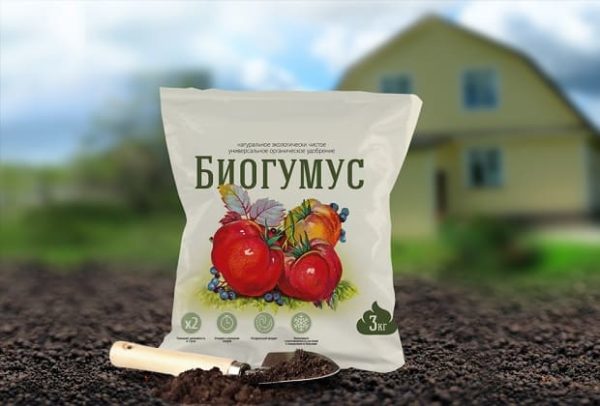

In the production of vermicompost, special Californian or Worm Prospector breeds are used.
Basic properties of vermicompost:
- biological product that does not pose a hazard to ornamental and fruit crops;
- the composition includes compounds of humic and mineral fertilizers.
Note!
Another name for vermicompost is vermicompost (which means recycled compost).
Vermicompost has a multicomponent composition:
- organic matter is combined with biological microelements;
- vitamins, enzymes and hormones necessary for the plant;
- necessary acids.
Vermicompost exceeds manure in terms of trace elements, its environment is neutral (pH 6.8-7.4). Small mounds of fresh earth can often be seen in the garden. This is the humus that worms produce. The worm passes the soil through itself. Thus, processing the main organic matter (manure, grass, foliage).
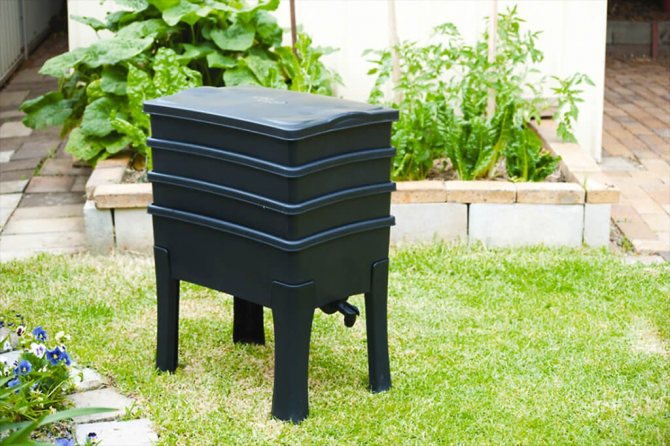

You may be interested in:
Farm for the extraction of vermicompost More and more people care about the environment, self-utilizing organic waste with the help of earthworms and, ... Read more ...
Once processed, the nutrients can be absorbed by plants. Unprocessed compost and manure are not assimilated by plants on their own. They consume the beneficial properties of a natural supplement in the form of humus. It can be concluded that worms are the main producers of vermicompost. The land processed by them is rich in trace elements, amino acids and natural antibiotics.
Dry vermicompost strengthens plants and improves their immunity. Plants develop stable disease resistance.
Storage and precautions
The fertilizer has a limited shelf life - no more than one and a half years from the date of production. When the period ends, the nutrients are no longer easily digestible. Store the product in a dry, dark place out of direct sunlight. You can put the fertilizer in the freezer, since it does not lose its beneficial qualities during the freezing / defrosting process.
The product is chemically safe, as it is completely natural. The granules are packed in plastic bags, keeping a certain level of moisture. This complies with fire safety standards: the powder preparation is difficult to ignite. However, when using vermicompost, precautions must be taken:
- protect hands with gloves;
- wash them thoroughly after work;
- in case of skin contact with the agent, hold the area where vermicompost has got into under running water.
Garden
Vermicompost is suitable for garden plants, vegetable gardens, greenhouses, trees and shrubs (including forest ones), lawns and indoor flowers.
Related article: Housing and communal services Vona Forte for cacti - reviews, description
In the garden, it can be used for planting and subsequent fertilization of any bushes, trees, flowers and herbs. Among other methods, the buds of flowers can be sprayed with humus - this increases the yield. You can also mulch fruitful trees and shrubs every year with a layer of vermicompost (about 2 cm).
When using vermicompost for plants in the garden, a significant increase in yield is observed. Thus, the yield of tomatoes and cucumbers can increase by 20-30%, potatoes - up to 40%, and greens - up to 45%.
The role of organic fertilizers
Organic fertilizers are the most important soil component. Organic matter is well digested by microorganisms and absorbed by plants. It is a substance rich in trace elements, which also affects the fertility of the soil. The more organic matter, the better the plants develop, the higher the yields.
Humus is a fertilizer that is constantly consumed, so its amount must be maintained on cultivated soils. This can be done using commercially available concentrates, like Baikal EM-1, containing bacterial colonies.
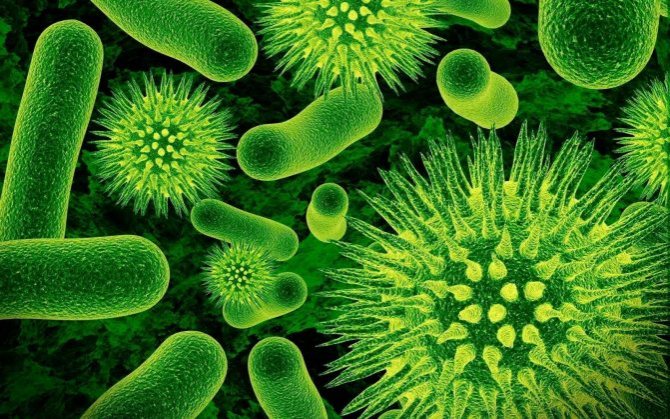

Once in the soil, in a favorable environment, they begin to multiply and eat plant debris. As a result, substances appear that are secreted by the digestive tract of microorganisms.
They are also useful in the fact that nutrients enter the soil in a chelated form, that is, "sealed" in an organic shell. In this form, plants absorb and assimilate food very quickly. The industry has learned to artificially create chelated fertilizers, which made it possible for summer residents to engage in environmentally friendly farming on their plots.
What is vermicompost for?
Farmers engaged in the cultivation of industrial crops often use mineral fertilizers haphazardly. Meanwhile, nature has invented gentle ways to solve this problem through the influence of earthworms. Small organisms have learned to recycle organic residues, forming a large number of coprolites. Worm excrement is an excellent material that contains potassium, phosphorus in a water-soluble form, and nitrogen. Fertilization of plants with vermicompost based on coprolites brings a quick and long-term effect.
What is the use of vermicompost for plants:
- There is an opportunity to significantly stimulate the development of economic crops.
- The soil is healed in a natural way.
- The plantings have increased immunity.
- If you are familiar with how to use biohumus, you can positively influence the process of engraftment of new seedlings.
- Ripening of fruits is accelerated.
- The quality of the crop is improving.
- The harmful effects of nitrates can be avoided.
- Vermicompost helps to reduce the number of pests.
Testimonials
Diana, 46 years old:
“Every year I use liquid fertilizer. But once every 3 years I additionally add granules. Organic matter has an excellent effect on all crops: I start harvesting earlier, fruits have richer color and taste, the shape is correct, without distortions. Thanks to the use of vermicompost, I extended the shelf life of potatoes. Earlier, after 2 months in the basement, it began to deteriorate. Now it lies normally all winter. "
Dmitry, 50 years old:
“I use vermicompost when processing seed and growing seedlings. Seeds hatch much faster, seedlings are friendly. The tool helps to get seedlings with plump trunks and a developed root system. Due to the latter circumstance, I began to use separate pots for forcing seedlings, since the roots are very tangled if the plants grow in the same box. "
Vermicompost is an effective top dressing. Its versatility confirms the possibility of using it for soil enrichment, acceleration of rooting, seed germination, and increased productivity.
Positive reviews
- minimum consumption
- is not expensive
- really helps plants
Good day to all, my dear readers and just guests of this site! In my next review, I will tell you about this miraculous groundbait for indoor plants from our domestic manufacturer. I'll start right away with the fact that I am a big lover of indoor flowers and therefore I have already tried many products from this category. The latter was exactly that, and I have already noticed. that my flowers liked it and therefore I. I bought it for 80 rubles in a flower shop, and then I saw it at Magnit-Cosmetics for 40 rubles altogether. It comes in a plastic bottle and is dark brown. His consumption is minimal, I personally pour one cap on a two-liter bottle. I mix everything and only then I water my plants. I feed about once a month. Plants begin to grow rapidly right before our eyes, acquire rich colors.
In general, I stayed and remain completely satisfied and recommend it to everyone!
I have never been distinguished by the fact that my plants are in excellent condition and form at home, on the contrary, I constantly forget to water, fertilize and put them in the sun, as a result, the result of such not careful care was that of all the potted plants I had only one dracaena, and now my goal was to preserve at least her, she had already grown decent, and it was just a pity to lose her. And then in the fall I brought home pots with petunias that grew on my street, I bought expensive and very beautiful petunias, I wanted to keep them until next season, and I heard that it was quite possible to do this.
On the advice of my mother-in-law, I purchased only one fertilizer "Biohumus", it is universal, as far as I understand, the manufacturer writes that it is suitable not only for indoor plants, but also for seedlings, there are several options for use for seedlings, we soak the seeds before planting (I have not used this yet) and watering seedlings with the addition of this fertilizer. But I have already tried to water the seedlings, although the effect is not noticeable yet, little is clear in a day. But my dracaena and petunias are very grateful to me every time I water them with water with the addition of "Biohumus", the fertilizer consumption is small, for watering ornamental plants one cap for three liters of water, and for seedlings to water one cap for one liter of water. I bought a bottle of one liter, so I think it will last for a long time, despite the fact that I have a lot of seedlings planned.
The cost of this fertilizer is low, for a container of one liter about eighty rubles, you can also buy a container with a volume of five hundred milliliters, which costs about fifty rubles, I think this price is acceptable for many and will not cause much damage to the budget, but what will help the plants for sure
- many fruits are tied after fertilization
Hello to all readers of my review! I want to tell you about such an excellent organic fertilizer for indoor plants as "Biohumus". I acquired it in joint purchases and did not regret it, because it differs from the others in its versatility and efficiency. By volume in a bottle of 0.5 liters of fertilizer.
It just so happened that in my house mainly citrus fruits grow, namely limonella and tangerine. They bloom three times a year, or even more often, and frequent fertilization and watering is a prerequisite for fruit to set. Previously, I used a special fertilizer for citrus fruits, but I did not notice the effect, because only two or three fruits were tied on tangerines.After the start of using Biohumus, as many as ten fruits were set on them for the first time! I was very happy. And for the first time in limonella, the tips of the leaves stopped turning yellow. I think I have found what I need for my flowers.
I use very simply on a 1.5 liter watering can I add one cap of fertilizer every week. Just be sure to keep it away from children.
In general, I am very pleased with my new fertilizer, one bottle is enough for a long time. Recommend.
Thanks for attention.
- Fertilizes
- gives pomp
- enhances growth
- inexpensive
Related article: Housing and communal services Sotka Gumi - reviews, description
Increased security measures
Good evening, dear readers of my reviews!
At home we always have a lot of indoor flowers, and for their care we buy various fertilizers. The spouse has his favorite rose, which he took (more precisely, he stole it from his mother, they say that if you steal a cut of an indoor flower, the flower will move away quickly and grow much better, which my husband did, discreetly cut it off with a sharp knife and put it in his pocket) with a small layering.
The husband loves his rose more than other plants, because he brought it very small, and now it has grown in three years about twenty meters, or maybe a little higher.
In the photo, unfortunately, our rose is not full-length, I photographed how our cat helped to loosen the earth =)
And in this photo our rose is 2 years old, and it blooms with such buds.
And this bud has already disappeared, they fall off after a week of beauty on the stem, or maybe our cat helps the buds with roses fall off when we are not at home, he is dirty, he may, but more inclined to the version, a hundred bud falls off by itself.
In this photo, the bud is about a week old.
Oddly enough, but with this fertilizer, our rose blooms all year round, despite the cold season. This year, it has just stopped blooming (but we water it with fertilizer and let's hope that it will continue to delight us with its red buds.
Or maybe transplants into a larger pot worked.
Let's go back to fertilization. This fertilizer affects the growth and density of plants, increases immunity and resistance to diseases, provides abundant growth and abundant flowering, and contains easily digestible nutrients.
We bought half a liter of fertilizer for 46 rubles. We dilute this fertilizer with 25 ml per 5 liters of water, which is enough for us to fertilize all our indoor plants, and sometimes even remains.
The shelf life of this fertilizer is three years from the date of manufacture, but we will end it much earlier.
But when processing, you need to be careful so that fertilizer does not get on the skin of the hands and especially the eyes. But if this trouble still happened to you, then it is worth rinsing with plenty of water using soap, if it gets into your eyes, you need to rinse with a huge amount of water.
And it also happens that it gets into the stomach (you can accidentally confuse, for example, bottles with fertilizer and someone can swallow, I myself had such a case in childhood, my mother spread the same fertilizer and placed it on the window without warning, and I wanted drink and swallowed accidentally) with such a hit, you need to drink a few glasses of water and induce vomiting, and it is advisable to consult a doctor, taking a bottle (or at least a label) with you.
After working with fertilizer treatment, be sure to wash your hands with soap and water.
This fertilizer was still used by my grandmother (who no longer exists), bought such fertilizer, bred in a bucket and fertilized all her flowers, and she had a lot of flowers.
So my mother uses this fertilizer, and she advised me to use this one.
Therefore, I will recommend this fertilizer, it is passed from generation to generation with us) the only thing that the manufacturer can only change.
Thank you all for your attention to my review and see you soon!
- contains chelated forms of substances
- easier for plants to absorb
Delicious food for houseplants and other plants plays a big role. However, as in human life. Many plants love to eat deliciously and nutritiously.
But feeding plants is also a science, like growing them.
Plants do not easily assimilate all substances, especially micro- and macroelements from the group of metals - iron, copper, zinc, lead, manganese, etc. They simply either do not completely digest them, or cannot use them at all, as they are for them unavailable for some reason. For example, iron or copper can react unexpectedly with some other substance in the soil. And in the process of an unforeseen chemical reaction, some other substance will turn out that is not useful or not at all necessary for the plant. And the plant just doesn't want to eat it. Such unnecessary substances can sometimes be observed in the form of whitish-reddish deposits on the walls of the pot or on the surface of the soil. They are very tough and I noticed that they do not even wash off when you wash the empty pot.
In recent decades, our chemical industry has begun to produce fertilizers in which all metal substances are in a form available for assimilation by a plant - a chelated form of a substance.
These include Biohumus. Organic fertilizer for indoor plants.
In the last year I have given up on powdered preparations of Kemir Lux, Agricola and others. It is inconvenient to dissolve them for a long time. I have a lot of plants, so the liquid form of fertilizers is convenient for me. And preferably in greater concentration, so that it will be enough for a larger number of times.
Biohumus "Power of Life" is a complex fertilizer. Contains humates and micro- and macroelements in moderation.
When buying any fertilizer, I always look at the constituent of the main elements - nitrogen, phosphorus, potassium, sulfur and magnesium.
Almost all complex fertilizers contain a balanced ratio, for example, nitrogen - 2 0, phosphorus - 10, potassium - 15, sulfur - 0.1, magnesium - 0.12. This is an almost ideal ratio, suitable for all plants. If a plant, for example a decorative deciduous plant, has more developed foliage, then it needs more nitrogen. It requires the proportion of nitrogen to be slightly higher, and slightly less phosphorus and potassium than in the example above.
Conversely, if the plant is flowering and is in the budding phase, that is, it is going to bloom. Such a plant needs a high concentration of phosphorus-potassium substances.
- the plants are happy - what more could you want
So spring has come, which means the plants are beginning to grow. But, unfortunately, with the growth of indoor flowers, nutrients are removed from the soil - and they are washed out with excess water, and the plant itself also takes them away.
Related article: KOU REASIL for Ficus - reviews, description
This is why concentrated fertilizers are sold. Last year, the seller advised me to use this fertilizer. And I am happy with the result. I bought this because the house has some of this list
This fertilizer is intended for:
- Monsters
- Begonias
- Asparagus
- Crotona
- Dracaena
- Dieffenbachia
- Ivy
- Ficus
- Palm trees have a wide range of plants.
Fertilizer accelerates the growth of the root system. Helps relieve plant transplant stress and provides plants with a long-term supply of nutrients. Any fertilization (of course for the varieties of home flowers) is beneficial! It's a pity the method of application is written in very small letters. Packaged in a plastic bottle, capacity 300ml. Dilute in water at the rate of 1 tsp for 7 liters of water. Water until the lump is completely wet. 1 time in 2-3 weeks.
But foliar feeding is also possible. Here, the solution should already be less concentrated - 1 tsp per 10 l of water. Also 2-3 times a week.
So if you have such flowers, then use them, it will not be worse.
Convenient packaging - won't break.
But in case of contact with mucous membranes, be sure to rinse under a strong stream of water
Well, for starters, what is it good for. You can fertilize plants with chemicals and you don't have to frown.Vermicompost also consists of atoms and also feeds plants with necessary substances. A distinctive quality of vermicompost, like any other organic fertilizer, is that it improves the structure of the soil, and besides that, it performs its usual functions.
Sam, your option for industrialists. Shmelev gave information for private traders and the only mistake was in manure aging. In fresh manure, not a single worm will dig, except for the authentic one. For me, for example, worms work in an ordinary, but "correct" compost heap, and even in an unusual and wrong one))) but there you have to take care of them, but there are more of them in the wrong one))))
Where is the catch, you ask? Nowhere. Vermicompost is good, good and good again.
I am not a gardener and not a gardener, but I really want beautiful, lush vegetation, at least in an apartment. There was no experience, so the plants I had were somehow unfortunate, they often died. I decided to try this fertilizer, I have been using it for about 6 months. My plants "came to life", I hope they will soon begin to bloom.
Fertilizer composition and properties
Vermicompost is an ideal fertilizer for plant nutrition, which does not harm the environment and humans. Vegetables grown with this top dressing are environmentally friendly and healthy for consumption.
Vermicompost contains:
- humates;
- sodium and potassium salts of humic acids;
- natural growth regulators;
- strains of nitrogen-fixing bacteria;
- fulvic acids;
- amino acids;
- spores of microorganisms inhabiting the soil;
- vitamins;
- microelements and macronutrients;
- natural phytohormones.
Natural feeding has a number of useful properties that help grow natural organic products... It:
- acceleration of seed germination;
- stimulation of growth and healthy development of the root system;
- acquisition of immunity to diseases;
- protection of plants from penetration of heavy metals into fruits;
- increased productivity;
- a decrease in the level of nitrates in fruits.
The use of vermicompost in a personal plot and at home will help to grow a rich and environmentally friendly harvest.
Why is biohumus used?
Biohumus or vermicompost is a type of biologically active organic feed. Fertilizing mass is obtained by processing natural agricultural waste by organisms living in the soil, in particular earthworms.
These beneficial soil dwellers digest organic debris and release a beneficial plant product called coprolite. The nutrients it contains are of a form that is easily assimilated by the green body.
The effectiveness of vermicompost is due to its rich composition, which contains macro- and microelements, enzymes, a number of soil antibiotics, vitamins, growth hormones. Biomass is extremely useful for garden and horticultural crops (in particular seedlings). We can also apply complementary foods to indoor plants.
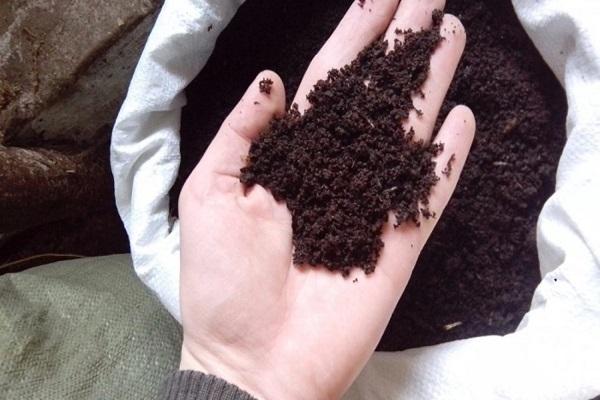

The list of biohumus components consists of:
- humates;
- amino acids;
- natural phytohormones;
- fulvic acid;
- spore of soil microorganisms.
Vermicompost contains 5-8 times more organic nutrients than complementary foods like manure and rotted compost. It is characterized by the absence of pathogenic microflora, helminth eggs, weed seeds.
Using this type of organic feeding, the soil is rehabilitated. It is perfectly compatible with other natural substances. Produces the following results:
- stimulation of the development of the roots of cultures;
- acceleration of seed germination;
- increased planting immunity to disease damage;
- acceleration of the onset of the flowering stage;
- stimulation of the ripening of the crop, increasing its quality characteristics;
- increasing the yield of planting;
- preventing the accumulation of nitrates in fruits;
- acceleration of rooting of small cuttings.
The biomass called vermicompost is rich in potassium, nitrogen, phosphorus. Nutrients are shaped so that the green body can absorb them easily and completely.
The positive impact of the introduced vermicompost on vegetation will last for several years (up to 5). It is impossible to oversaturate the soil with it due to the natural composition, which excludes the presence of chemical harmful substances.
What fertilizer will give to plants
- The unique biohumus contributes to the rapid growth of plants, perfectly develops the root system, and also increases the number of leaves and flowers appearing on the stems.
- Able to affect the splendor of flowering.
- Increases the plant's immunity, strengthens its resistance to temperature extremes, all kinds of diseases, which are susceptible not only to street flowers, but also to indoor flowers.
- After transplanting, vermicompost helps the flowers quickly take root in a new place, quickly recover from the stress received.
- Allows indoor plants to be nourished with nutrients.
- Plants receive a rich supply of vitamins for a long period of time.
- Microorganisms useful for it develop in the soil, which contribute to the formation of humus in the ground. This is great for plants.
Judging by the numerous enthusiastic reviews, vermicompost works great on indoor plants. They rarely get sick, bloom longer and take root incredibly quickly. That is why you should give up all your household chores and rush to get a delicious treat for your favorite flowers.
Influence of vermicompost on plants
Having studied the whole range of useful properties of biofertilizer for crops, one can better understand what biohumus is and how to use it in agricultural technology.
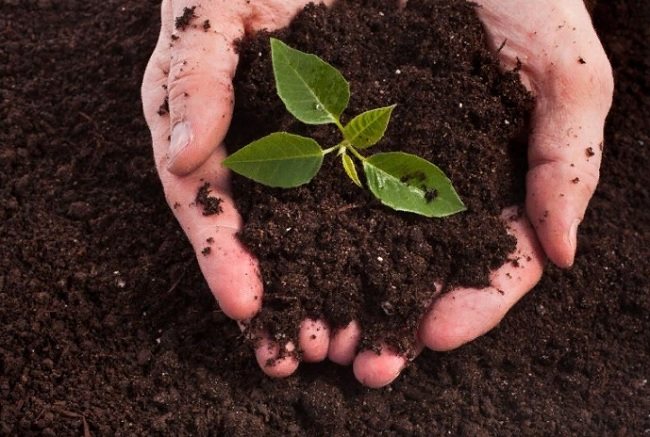

- Vermicompost does not contain harmful substances, pathogenic microflora - dangerous pathogenic bacteria, eggs, larvae of insect pests, nitrates and heavy metals, weed seeds.
- It is able to increase the immunity of plants, they become healthy, they resist frost and drought, diseases, and insect pests well.
- Increases seed germination at times.
- Improves the survival rate of plants, especially when they are transplanted, planting seedlings.
- Stimulates the growth and development of crops, increasing the yield.
- Almost doubles the yield.
- Improves the taste of vegetables and fruits.
- Increases the rate of fruit ripening.
No other chemical fertilizer has such a wide range of possibilities as vermicompost. It is known that mineral fertilizers are not fully assimilated by plants and tend to accumulate in the soil.
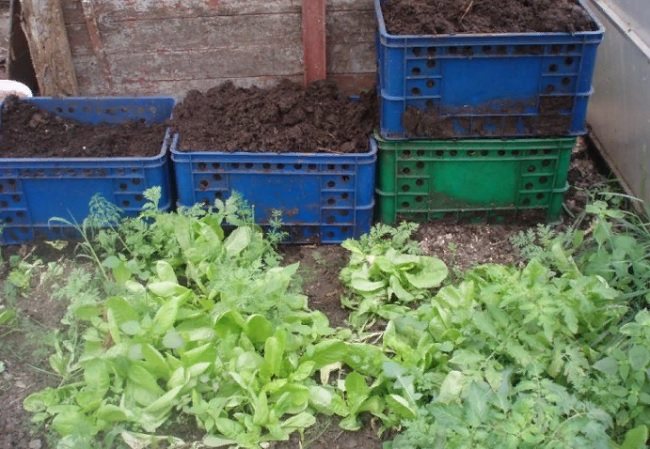

Plants assimilate vermicompost almost completely. This organic composition, which includes a large amount of humic acids, is able not only to put the soil in order, but also indirectly, through the fruits of plants, to heal a person.
After all, plants are actively enriched with those useful substances, amino acids, microelements that are necessary for the life of people. Humic acids have a positive effect at the cellular level, entering the human body along with plant foods, reducing mutations and the risk of oncology.
What is vermicompost and what is its use
Vermicompost (vermicompost) is an environmentally friendly natural fertilizer, a product of "digestion" of all kinds of organic matter (even organic waste) by red Californian worms. You can buy it at most agricultural stores or directly from the suppliers who manufacture it.
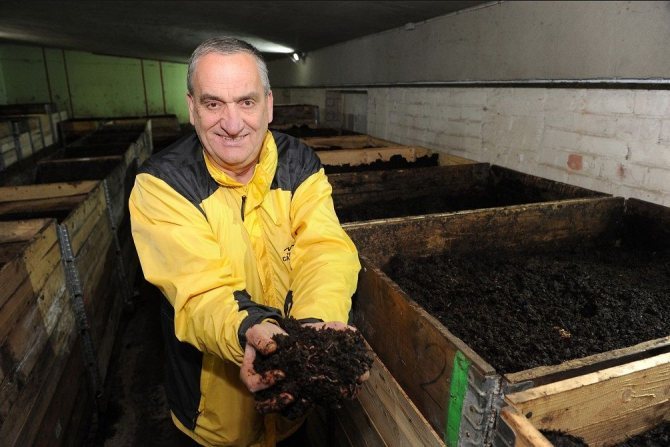

Biohumus is produced by red Californian worms, any organic matter is suitable as a raw materialBiohumus is produced by red Californian worms, any organic matter is suitable as a raw material
Top dressing is mainly used to restore and maintain soil fertility. Vermicompost provides an effect comparable to that of manure and humus, but without their inherent disadvantages.For example, there is no unpleasant pungent smell characteristic of manure, there is no risk of "burning" the roots of the plant with an excess of fertilizer. When using humus at the same time as top dressing, all kinds of pathogens and unwanted fauna can get into the soil.
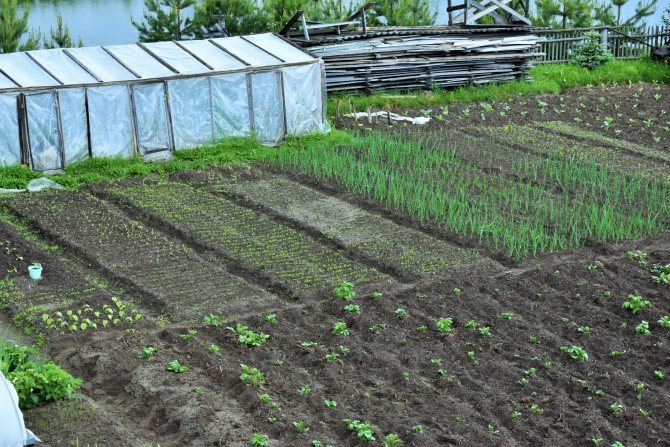

Regular cultivation of crops, even with the observance of crop rotation, depletes the soil, so it needs replenishment "from the outside"
The fertilizer cost is quite affordable. The price of 10 liters of ready-made liquid top dressing starts from 250 rubles, a liter of concentrate - from 85–90 rubles. Dry vermicompost costs in the range of 450-500 rubles per bag of 25 liters.
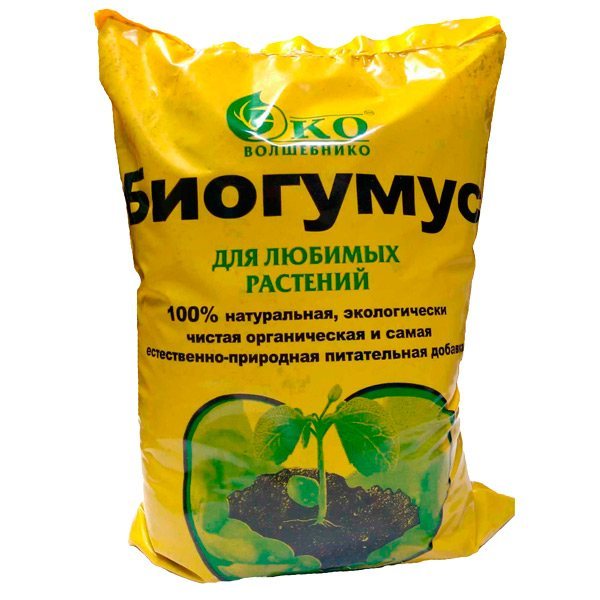

Vermicompost is produced in different volumes and types, accordingly, the price also varies
How to dilute liquid vermicompost?
The drug is supplied in a convenient plastic container, so home-breeding of vermicompost is a simple matter. You should always carefully read the instructions and the subcortex of garden plants will bring tangible benefits. We prepare concentrated fertilizer as follows:
- For convenience, many companies make a cap of a strictly defined volume, stipulating this in the instructions; in this case, it is not required to purchase special measuring cups.
- The proportions for each crop are often different, if a concentration of 100 ml / 10 l is suitable for vegetables, then for berry bushes or trees it is 250 ml / 10 l.
- Having diluted vermicompost with water, it is better to let the liquid stand for up to 4 hours until the active substance is completely dissolved.
- We apply top dressing according to the table, which is always given on the fertilizer label.
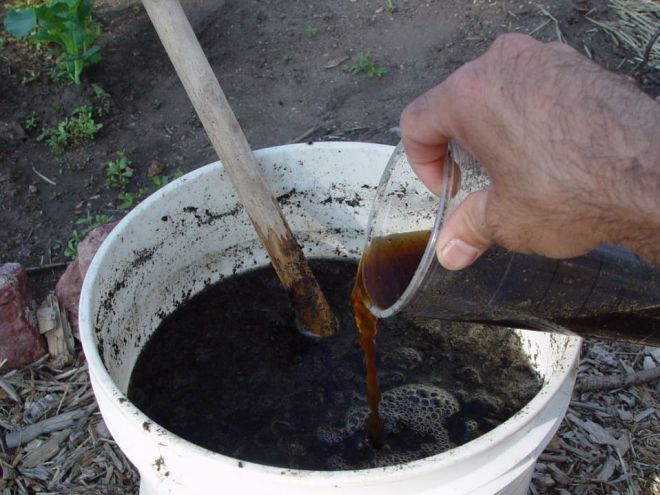

Beneficial features
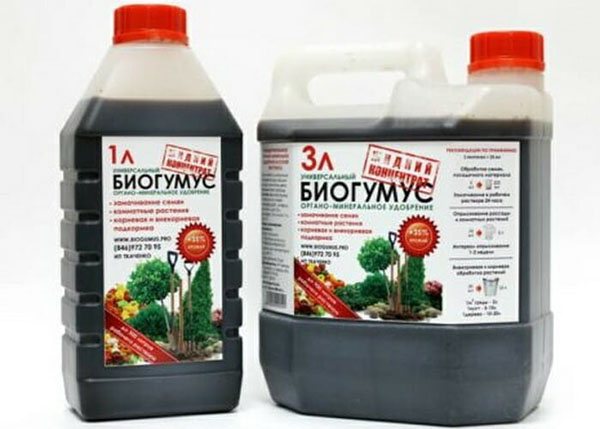

Fertilizer vermicompost liquid has a complex effect on plants:
- promotes the development and strengthening of roots, growth and development of stems;
- improves photosynthesis;
- improves protective properties against diseases (powdery mildew, rot) and pests;
- accelerates flowering, ripening and increases productivity;
- improves survival rate after transplanting seedlings into the ground;
- reduces the content of nitrates, heavy metals, increases the amount of useful vitamins, microelements.
The organic composition of the fertilizer serves as a prophylaxis against the accumulation of nitrates in plants, which cause cancer in humans.
Biohumus liquid for roses
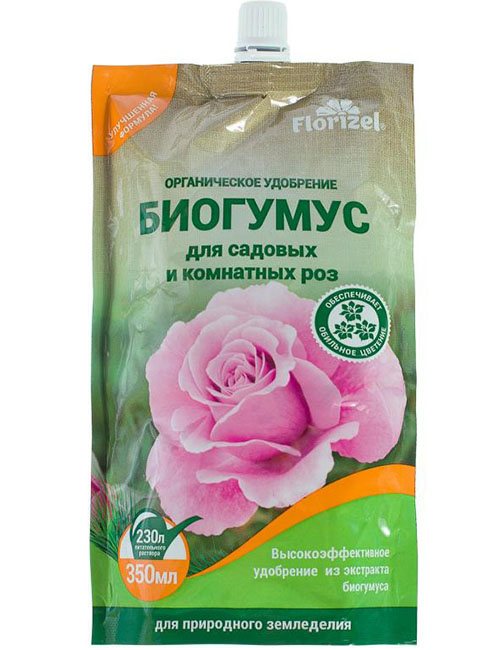

During the growing season for roses, regular feeding with a moderate amount of phosphorus, potassium, nitrogen, trace elements is required. The optimal means for their foliar feeding is liquid biohumus (vermicompost) fertilizer. It is sprayed over the leaves with a sprayer or spray bottle during quiet evening hours.
Humus feeding makes the flowers brighter, more saturated, accelerates the formation of buds. A separate type of packaging of liquid vermicompost with a capacity of 0.5 liters is called "Queen of flowers Vermicompost for roses". 1 cap of concentrated solution contains 10 milliliters. It is dissolved in 1 liter of water and sprayed with roses.
Fertilizer is also used for feeding flowers in an apartment or greenhouse in the amount of 2-5 tablespoons per flower pot (depending on its volume). To do this, use "Growing Biohumus" or a 1-liter container "Milk from a worm".
Storage
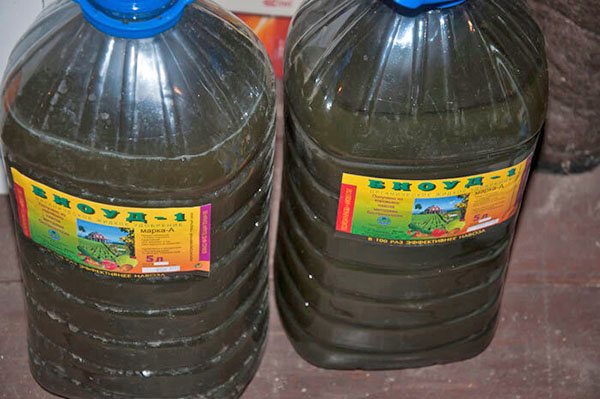

The manufacturer determines the shelf life of packaged liquid vermicompost from 1.5 years to infinity. It should be stored in a dark place, away from bright sunlight. Fertilizer is safe for plants and people performing work on preparing the solution and spraying on plants. It is enough to use rubber gloves during work and wash your hands thoroughly with soap after finishing the treatment of plants.
Universal organic fertilizer vermicompost fills the soil and growing crops with a complex of useful substances, protects them from diseases, wilting, promotes good growth, development, and increased productivity.Scientific experiments with the use of humus feeding indicate an increase in the yield of berry, fruit, vegetable crops from 20 to 40 percent. The use of vermicompost completely eliminates the need for chemical fertilizers.
Liquid vermicompost is a concentrated solution for plant fertilization, made on the basis of natural raw materials. It contains nutrients, growth stimulants, organic elements that accelerate the absorption of useful components. The liquid structure of the fertilizer helps to easily carry the necessary substances to the roots of the plant and quickly penetrate deep into the depths.
Precautions
The use of liquid vermicompost does not require any special precautions, since the substance is not poisonous.
To prevent fertilizer from getting into the stomach or mucous membranes, and also from penetrating the skin through a series of microcracks, it is enough to put on rubber gloves before work, and at the end of it - wash your hands well with soap and water.
The liquid is packed in polyethylene bottles, which are completely safe from the point of view of fire regulations.
Important! If, nevertheless, drops of fertilizer get into the eyes or on the skin, rinse them well with plenty of running water, if swallowed, wash the stomach with a weak solution of potassium permanganate.
Application features
Vermicompost preparation may differ depending on the purposes for which it is used. To make a solution suitable for soaking seeds, liquid vermicompost is dissolved in water in a ratio of 1:20. Each culture has its own holding time in the infusion:
- legumes cannot be kept for more than 6 hours;
- lettuce or radish seeds are soaked for up to 12 hours;
- onions and potato tubers are dipped for half an hour before planting;
- seeds of vegetables and melons and gourds - 24 hours;
- dill or parsley seeds can withstand no more than a day.
Seed treatment with vermicompost has a disinfecting effect, additionally disinfecting them. This is achieved due to special enzymes that are produced in the tissues of worms that process raw materials for humus.
When picking seedlings into separate pots, the solution is added to the pits under the sprout. To do this, it is diluted in water in a ratio of 1:50 to avoid burns of delicate roots. The solution promotes better rooting and accelerates the recruitment of green leaves. For spraying plant foliage, the concentrate is diluted in a ratio of 1: 200.
The procedure is carried out in the phase of active growth, as well as during the formation of fruits.
For home flowers, it is recommended to dilute 30 ml (this is about one cap from the container into which the drug is poured) in 3 liters of water, and water until the soil in the pot is completely soaked. Root crops are fed only by the root method, spraying will lead to an increase in the green mass, to the detriment of the fruit itself. For this, 2-3 caps of the drug are diluted in 3-4 liters of water.
It is important to remember that the use of vermicompost is unacceptable in soils where peat is the main component. Fertilizing will lead to severe burns of the root system and death of the plant. If, unknowingly, feeding still occurred, the plant should be removed from the ground and placed in water. With a low degree of damage, the plant will revive very quickly and return to normal.
Vermicompost infusion is a valuable and convenient way to fertilize plants. It is great for horticultural and horticultural crops, and also enhances the decorative properties of home flowers. The absence of an unpleasant odor and ease of preparation make it affordable even for novice gardeners, allowing it to be regularly used for plant nutrition. Nutrients and vitamins accelerate the development of the plant, strengthen its protective functions, and improve the taste and quality of the fruit.
Organic fertilizer containing microorganisms useful for soil and plants was named liquid biohumus.
Its main component is compost processed by red Californian worms (or their analogue - the Russian Moscow hybrid), which significantly improves the fertility of the soil composition.
Varieties
- Industrial vermicompost is produced in different forms: in liquid form, in the form of paste, in dry form in bags.
- Biohumus in industrial form is an extract, i.e. contains a maximum of nutrients.
A liquid working solution of vermicompost is prepared using water according to the standards and recommendations specified in the instructions. In this case, the consumption is economical.
So, to prepare an aqueous solution of liquid biohumus, 50 ml of fertilizer will be required per 10-liter bucket of water for root feeding.
In dry form, vermicompost resembles ordinary soil. It contains all the necessary organic nutrients in a balanced and easily digestible form for plants, as well as nitrogen, phosphorus, potassium and other trace elements important for growth and development.
Structure
The main difference between the product and its analogues is its complex composition. A large proportion is represented by organic substances, including natural plant amino acids, vitamins, gluconic acid and polysaccharides. They act as natural growth catalysts and have a positive effect on soil properties.
Also, there are microelements in different quantities. They are added taking into account the needs of different types and varieties of plants for their complete nutrition. The peculiarities of the composition of each form of the Vermicompost preparation are presented in the table.
| Element,% | For potatoes | For fruits and berries | For vegetables and tomatoes | For indoor plants and seedlings |
| Organic part | 30 | 30 | 30 | 35 |
| Nitrogen | 4 | 4 | 4 | 8 |
| Phosphorus | 5 | 4 | 5 | 3 |
| Potassium | 6 | 7 | 6 | 4 |
| Calcium | 2 | 2 | 2 | — |
| Magnesium | 1 | 1 | 1 | 1 |
| Boron | 2 | 2 | 2 | 0,05 |
| Copper | 0,3 | — | 0,3 | — |
| Cobalt | 0,02 | 0,02 | 0,02 | 0,02 |
| Iron | 1 | 0,8 | 1 | 1 |
| Manganese | 0,6 | 1 | 0,6 | 0,6 |
| Molybdenum | 0,05 | 0,02 | 0,05 | 0,02 |
| Zinc | 0,8 | 1 | 0,8 | 0,8 |
Strawberries at home all year round! These veneers are 100 times better than a false jaw! And there are pennies! Up to 15 kg of strawberries every month! False dental veneers for a penny! Up to 15 kg of strawberries every month! Famous overhead veneers are now in Russia!


